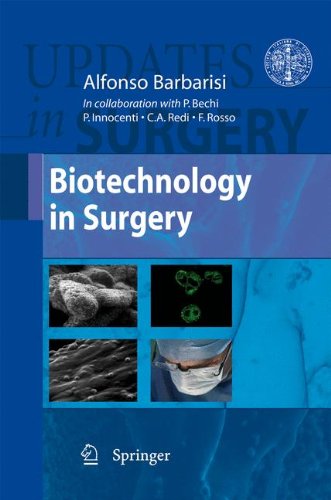بیوتکنولوژی در جراحی ۲۰۱۰
Biotechnology in Surgery 2010
دانلود کتاب بیوتکنولوژی در جراحی ۲۰۱۰ (Biotechnology in Surgery 2010) با لینک مستقیم و فرمت pdf (پی دی اف)
| نویسنده |
Alfonso Barbarisi, Carlo Alberto Redi, Francesco Rosso, Paolo Bechi, Paolo Innocenti |
|---|
| تعداد صفحهها |
194 |
|---|---|
| نوع فایل |
|
| حجم |
4 Mb |
| سال انتشار |
2010 |
89,000 تومان
معرفی کتاب بیوتکنولوژی در جراحی ۲۰۱۰
قرن بیستم به پایان رسیده است، قرنی که در آن جراحی به لطف پیشرفت های تکنولوژیک گام های بزرگی رو به جلو برداشت. اکنون وارد “قرن بیوتکنولوژی” شده ایم که نه تنها به پیشرفت در جراحی، بلکه به یک “انقلاب فرهنگی” واقعی منجر می شود که رویکردهای حل مشکلات مختلف در پزشکی را کاملاً تغییر خواهد داد. هدف این کتاب نزدیک تر کردن جراحان به بیوتکنولوژی و غلبه بر شکاف فرهنگی است که آنها را از این رویکردهای جدید جدا می کند. بیوتکنولوژی ها قبلاً در سطوح مختلف در عمل جراحی پیشنهاد شده و مورد استفاده قرار گرفته اند: در فناوری تشخیصی، پزشکان را قادر می سازد تا بیماری ها را در مراحل اولیه شناسایی کنند و تغییرات مولکولی آنها را در طول زمان دنبال کنند. و در مهندسی بافت، جایی که استفاده از “داربست های هوشمند” پاسخی بالقوه به تقاضای فزاینده برای بافت ها و اندام های زیست سازگار در جراحی پیوند می دهد. این جلد بر حوزه نوظهور سلول های بنیادی تمرکز دارد و نقش آن ها را به عنوان بازیگران بالقوه در پیدایش و تداوم سرطان – «سلول های بنیادی سرطانی» – و برعکس، پتانسیل درمانی فوق العاده آن ها تحلیل می کند. بخش دیگری به ارزیابی و کاربرد عوامل مولکولی مشتق شده اختصاص داده شده است که می توانند فرآیندهای فیزیولوژیکی از اهمیت اساسی در جراحی مانند هموستاز و بهبود زخم را افزایش دهند. جراحان همیشه متخصص فنی بوده اند، به این معنا که از زمان شروع جراحی، از اسکالپل و ابزار جراحی، همیشه به فناوری نیاز داشته اند. آنها همیشه با فناوران همکاری داشته اند. با این حال، در قرن جدید، در قرن اول هزاره، افزایش سریع دانش که خارج از محدوده آموزش فنی سنتی جراح بود، خود را دیکته کرد – از این رو هدف این کتاب است. اکنون ضروری است که جراحان را تشویق کنیم تا با اطمینان از این دانش (بیوتکنولوژی) استقبال کنند. بیوتکنولوژی طبیعتاً با تکنیک های مورد استفاده تاکنون کاملاً متفاوت است، زیرا از حواس بینایی و لامسه که تاکنون هسته اصلی کار جراح بوده است، فرار می کند. ابعاد سلولی و مولکولی بیوتکنولوژی هنوز با پیشرفت های اخیر در تکنیک های جراحی مدرن فاصله دارد. زبان مشترک بین جراحان و بیوتکنولوژیست ها انقلابی بیشتر در علوم جراحی قرن بیست و یکم ایجاد خواهد کرد.



